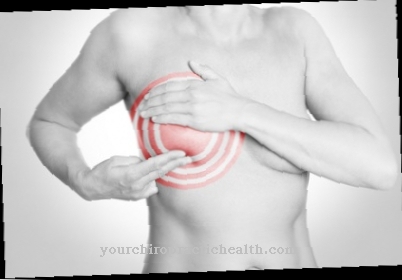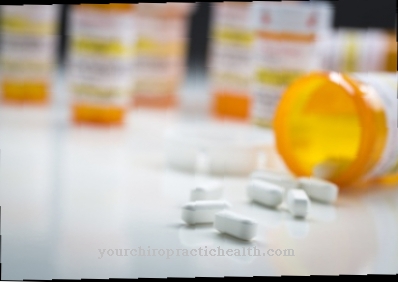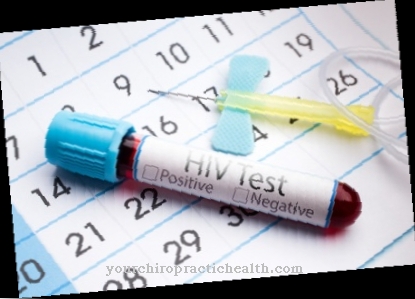With the active ingredient Tazarotene it is a retinoid. The drug is usually used externally. It is applied locally in the form of gel or ointment for the therapy of psoriasis (psoriasis) of the plaque type. The drug is also called tazarotene or Tazarot designated.
What is tazarotene?

The drug tazarotene is a retinoid that has receptor-selective and topical properties. These are a special type of retinoids that belong to a new generation of pharmacology.
The active ingredient is primarily used in the treatment of mild to moderate plaque psoriasis. After absorption through the skin, the substance is metabolized into a metabolite called tazarotenic acid in a relatively short time. However, the structure is not very similar to vitamin A or other retinoids that have been used in therapy up to now. These include, for example, acitretin, isotretinoin and etretinate.
Nevertheless, the active ingredient tazarotene is counted as a retinoid with a so-called ethine structure. Tazarotene is generally sensitive to oxygen and other oxidizing agents as well as light and substances that have an alkaline reaction.
Pharmacological effect
The drug tazarotene works primarily by affecting the formation and growth of cells. The substance also has anti-inflammatory effects. However, according to the current state of medical research, the exact mechanism of the action of tazarotene is not yet fully known.
The drug tazarotene connects to the so-called retinoic acid receptor and sets in motion a modification of gene expression. The active ingredient also influences the differentiation of cells. In the course of treatment, care must therefore be taken to ensure that patients avoid direct and intense UV radiation. Basically, the drug in Germany is subject to both pharmacy and prescription.
Medical application & use
The drug tazarotene is suitable for the therapy of various diseases, but it is mainly used to treat psoriasis. Gel preparations with various concentrations of the active ingredient exist for this purpose. These are intended for the topical therapy of small-scale, mild to moderate psoriasis of the plaque type.
First of all, together with the attending physician, the individually appropriate concentration of the active substance in the gel must be determined. Gels with higher concentrations cause skin irritation more often than lower-dose preparations. For example, reddened areas of the skin or itching are possible. However, the effect is stronger according to the higher dose and also occurs more quickly.
Before applying the gel, make sure that the affected skin areas are dry. If the gel is applied after a shower, the skin must be dried thoroughly. In the majority of cases, the tazarotene gel is applied once a day before going to bed. It is important that only a thin layer is applied to the skin. It is also important to ensure that only the psoriatic skin areas are wetted with the gel. This avoids irritation of healthy or inflamed skin.
The gel must not come into contact with the eyes, and hand washing is necessary after applying the medication. If the affected patients suffer from psoriasis in the hands, particular care must be taken to ensure that the gel does not get into the face or eyes. If this does happen, the eyes should be rinsed out immediately with a large amount of cold water and, if necessary, a doctor should be consulted.
Risks & side effects
A large number of undesirable side effects and complaints are possible as part of therapy with the drug tazarotene. These differ from patient to patient and vary depending on the individual case. The most common side effects are a burning sensation on the skin as well as reddened skin areas, itching and localized irritation.
In addition, rashes on the skin, flaking, contact dermatitis, pain and a worsened condition of psoriasis are other possible side effects. In addition, inflammation on the skin and dry skin areas occur.
Various interactions with other agents must be observed during treatment with a tazarotene gel. It is advisable to avoid drugs that irritate and dry out the skin. It should therefore not be used at the same time as tazarotene.
There are also some contraindications for which the drug tazarotene must not be used. These include, for example, known intolerance to the substance tazarotene as well as exfoliative psoriasis and pustular psoriasis. The drug should also not be applied to the face or scalp.
Therapy with tazarotene lasts a maximum of twelve weeks, with no more than ten percent of the body surface being treated with the gel. Treatment with the drug tazarotene should be avoided during pregnancy and lactation.
The drug tazarotene shows a teratogenic effect following oral ingestion. Animal experiments have shown that changes in the skeleton of fetuses have occurred after dermal application. If side effects or other complaints occur during therapy with the drug tazarotene, the attending physician or, in an emergency, a pharmacist should be consulted immediately.
























.jpg)



